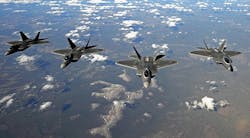DARPA wants new ideas to create reconfigurable aircraft networking in battlefield conditions
ARLINGTON, Va., 19 Oct. 2015. U.S. military researchers are asking the defense industry for ways to network U.S. and allied combat aircraft in the presence of the enemy. Researchers are looking for ways to exchange priority data via aircraft networking in battlefield conditions.
Officials of the U.S. Defense Advanced Research Projects Agency (DARPA) in Arlington, Va., have issued a broad agency announcement (DARPA-BAA-16-06) for the Dynamic Network Adaptation for Mission Optimization (DyNAMO) program, which seeks technologies that enable network interoperability among airborne platforms in adversarial environments.
The DyNAMO is intended solve a critical problem in the nation’s ability to conduct operations against enemies with similar technological capabilities, DARPA officials say.
Today's lack of interoperability among existing networks inhibits information sharing among different aircraft, and legacy networks require configuration in advance of a mission and cannot adapt to changing battlefield conditions like time-varying jamming and bursts in network traffic caused by time-sensitive collaborative targeting, networked weapons, and non-traditional intelligence, surveillance, and reconnaissance (ISR).
To overcome these kinds of limitations, the DyNAMO program seeks to develop networking technology that can link today's military networks that cannot communicate because of formatting, security levels, and other limitations.
At first the program will focus on interoperability among existing networks like Link 16, Tactical Targeting Network Technology (TTNT), Intra-Flight Data Link (IFDL), and Multifunction Advanced Data Link (MADL). Efforts seek to develop adaptive network technologies and demonstrate interoperability across legacy and future dynamic networks and communications waveforms.
Participants will demonstrate DyNAMO network technology on radio hardware developed on DARPA’s Communications in Contested Environments (C2E) program, which is designing new radio and waveform technologies and demonstrating them in interoperable implementations of standard airborne networking waveforms.
DyNAMO seeks technologies that enable independently designed networks to interoperate and allow networks to adapt to time-varying mission needs in dynamic RF environments, with over-the-air experiments to demonstrate data sharing across legacy networks and future adaptive networks.
DARPA researchers are focusing on three primary enabling technologies to help achieve DyNAMO program goals:
-- an information network that shares critical information among disparate networks;
-- a network optimizer that adapts radio parameters to create pathways for priority radio traffic in the presence of the enemy; and
-- integrating these two technologies into a system of real radios.
Related: Leidos chosen to participate in DARPA C2E program to develop jam-resistant communications
The goal of the information network is to find an efficient way to share information across today's incompatible networks. The network optimizer seeks to create techniques to adapt radio parameters in reaction to changing information needs and environmental conditions. Systems integration seeks to develop system designs to interconnect applications and information across several legacy and future networks.
The first one-year phase of the DyNAMO program focuses on information flow across and among, existing aircraft networks. If results are promising, DARPA may conduct an over-the-air field test.
The program's second phase would be to demonstrate the final DyNAMO technologies on radio hardware in a realistic battlefield environment. This part of the program would take 19 months.
Companies interested should submit abstracts no later than 28 Oct. 2015 to the DARPA BAA Website at http://baa.darpa.mil. Full proposals are due to the DARPA BAA Website no later than 4 Dec. 2015.
Email questions or concerns to DARPA at [email protected]. More information is online at https://www.fbo.gov/spg/ODA/DARPA/CMO/DARPA-BAA-16-06/listing.html.

